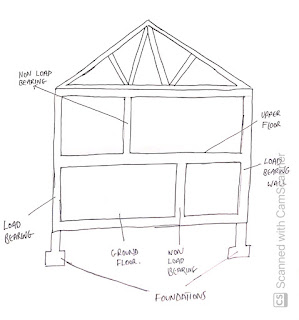Walls
Walls are a fundamental part of a building. a wall is a solid structure that rises vertically and distributes loads from the roof to the foundations. with regard to there structure of the building, walls can be classified into two types.
Load bearing: These walls rest on foundations in order to spread the loads from the top of a wall, through the wall, to the ground.
Non-load-bearing: These walls, which may or may not rest on foundations, are generally used to divide internal spaces between rooms.
External Load-bearing walls need to sit on a foundation. These walls take the weight of the roof and must therefore distribute loads to the foundations. The main function of an external wall is to prevent moisture penetrating through to the inner surface.Cavity walls: The most common and modern method is using two walls with a cavity between them. Moisture is absorbed by the outer leaf but the cavity prevents this moisture from reaching the inner leaf. The inner leaf of a cavity wall is the load-bearing one, while the outer leaf protects it from damage and weathering. Wall ties help to bind the inner and outer leaves so that they act as one. They improve buildings structural stability by unifying the two walls and reducing shear stress.
Party Walls
A party wall is a share wall which separates one building from its neighbour. when these two buildings are homes each residence has half of the wall on its property. the two main functions of a party wall are to prevent the spread of fire and to prevent the transmission of sound. These walls I must consider as of the estate I will be building will require party walls to separate each housing.
Party walls are two completely separate walls, with no bridging except from non-combustible insulation, which is packed in at the top. after it is filled with this non combustible material, the wall is capped with mortar. Allowing this cavity to run from the foundation to the top of the party wall ensue that dire will jot spread, and that the transmission of noise from one building to its neighbour is reduced.





Comments
Post a Comment